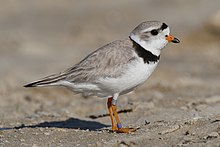Piping plover
| Piping plover | |
|---|---|
 |
|
| Sauble Beach, Ontario, Canada | |
| Scientific classification | |
| Kingdom: | Animalia |
| Phylum: | Chordata |
| Class: | Aves |
| Order: | Charadriiformes |
| Family: | Charadriidae |
| Genus: | Charadrius |
| Species: | C. melodus |
| Binomial name | |
|
Charadrius melodus (Ord, 1824) |
|
| Subspecies | |
|
|
The piping plover (Charadrius melodus) is a small sand-colored, sparrow-sized shorebird that nests and feeds along coastal sand and gravel beaches in North America. The adult has yellow-orange legs, a black band across the forehead from eye to eye, and a black stripe running along the breast line. This chest band is usually thicker in males during the breeding season, and it is the only reliable way to tell the sexes apart. The bird is difficult to see when it is standing still, as it blends well with open, sandy beach habitats. It typically runs in short spurts and stops.
There are two subspecies of piping plovers: the eastern population is known as Charadrius melodus melodus and the mid-west population is known as C. m. circumcinctus. The bird's name is derived from its plaintive bell-like whistles which are often heard before the bird is visible.
Total population is currently estimated at about 6,510 individuals. A preliminary estimate showed 3,350 birds in 2003 on the Atlantic Coast alone, 52% of the total. The population has been increasing since 1999.
Their breeding habitat includes beaches and sand flats on the Atlantic coast, the shores of the Great Lakes, and in the mid-west of Canada and the United States. They nest on sandy or gravel beaches or shoals. These shorebirds forage for food on beaches, usually by sight, moving across the beaches in short bursts. Generally, piping plovers will forage for food around the high tide wrack zone and along the water's edge. They eat mainly insects, marine worms, and crustaceans.
The piping plover is a stout bird with a large rounded head, a short thick neck, and a stubby bill. It is a sand-colored, dull gray/khaki, sparrow-sized shorebird. The adult has yellow-orange legs, a black band across the forehead from eye to eye, and a black ring around the neck during the breeding season. During nonbreeding season, the black bands become less pronounced. Its bill is orange with a black tip. It ranges from 15–19 cm (5.9–7.5 in) in length, with a wingspan of 35–41 cm (14–16 in) and a mass of 42–64 g (1.5–2.3 oz).
...
Wikipedia

